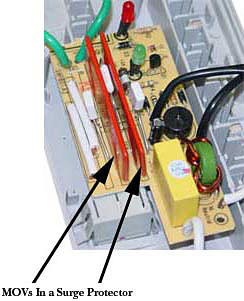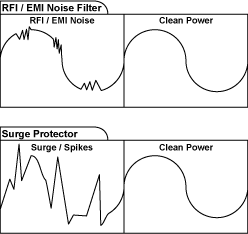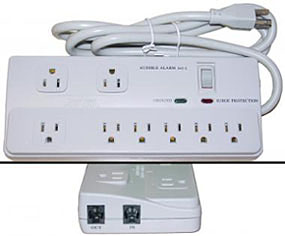All About Surge Protectors
 6-Outlet Protector with Fax/Phone Protection |
Everybody knows that a surge protector is important for protecting electronic equipment, but many do not know why they are important, where they fall short in protection, or even how they work. We hope to help you understand more about how surge protectors can help you, and give you a basic guide for choosing the right protector for your needs. |
Why Do I Need One?
Power surges are basically an increase in the current flowing to your wall. These surges can occur for a number of reasons.
The most familiar reason is lightning. If lighting strikes near a power line above or below the ground, this causes an increase in the electrical pressure headed for your house. This creates an enormous surge that can destroy electronic devices, start a fire in the house or even electrocute someone using an appliance.
Though these types of surges are probably what someone thinks of first when one mentions surges, they are not only very uncommon, but they would also overwhelm almost any surge protector along with the appliances that are connected to it. Never rely on a surge protector in a thunderstorm. Unplug your devices for absolute safety.
Much more common, and perhaps a bit underestimated, are more subtle, daily surges. When refrigerators, heaters, air conditioners, and other power-hungry appliances kick on there is a sudden, brief demand for more power. Anyone who's ever seen the lights flicker when one of the appliances kicks on knows what I'm talking about. These small power disruptions can, immediately or over time, wreak havoc on the sensitive components found in equipment such as computers and home theater equipment. This scenario is perfect for surge protectors.
How Do They Work?The most common surge protection used in the surge protectors is a metal oxide varistor or MOV. A MOV is made of a special material called a semiconductor. Semiconductors only conduct electricity under certain special conditions. If these conditions are not present, no electricity can pass through the semiconductor. In a MOV, the special condition is a certain high level of voltage. Basically, if the voltage, or flow of electricity, is at a normal level, the MOV does nothing. When a surge of power travels through the line, the MOV is then able to conduct electricity and so it siphons off the excessive power, transferring it away from the device, safely into the ground. The MOV only siphons off the amount of power that's ABOVE the normal level, so the TV or PC continue to run during this surge. The device connected to the surge protector actually has no idea that there was a surge in the line. It continues to operate as if nothing happened. |

|
Now, the inherent problem with MOVs is that, with all the small surges happening all the time, they can wear out. Most surge protectors contain more than one MOV, but if the MOVs burn out, that means all surges will have nowhere to go but straight to the devices connected to the protector. This is why it is important to choose a protector with some type of indicator letting you know when MOV protection has failed, so you know to stop using the protector. These indicators can be an LED light or an audible buzzer.
Another type of surge protection is a gas discharge arrestor, or gas tube. They basically do the same thing as a MOV, siphon off excess voltage and dump it into the ground. But, instead of a semiconductor, gas tubes use a special gas that only conducts electricity when voltage rises above the normal levels.

|
Additional ProtectionSome surge protectors also offer fuses as a backup. These fuses can only handle a certain level of voltage. When the voltage rises above that level, the fuse actually melts, immediately stopping all current from flowing to the connected devices. These are great as a backup, if your MOVs burn out and you don't know it. If the MOVs aren't there to stop the surge, than the fuse will melt and take care of the job. |
|
With modern home theaters and complex computer systems becoming more and more
common, surge protection is no longer just about power cords. Telephone lines
as well as cable TV lines can carry large surges as well, potentially
damaging expensive equipment. Many surge protectors can be found that include
connections for phone, internet, or cable lines. These typically contain
fuses, much like the backup fuses discussed above. Again, if the voltage spikes
too high, the fuse melts and saves the devices attached to the protector.
An even further level of protection for your really high-end devices is the use of line conditioners. Even when a surge in a power line isn't present, the voltage level still fluctuates slightly, up and down. Over time, even these slight ups and downs can damage the highly sensitive components of some modern devices. Line conditioners help to smooth out the fluctuations in the voltage using electromagnets. The smoothed-out voltage is then considered "conditioned." |

|
Choosing the Right Protector for You
There are a few things to consider when choosing a surge protector. The first is what devices you are planning on protecting. A lamp, for example, needs no protection since, if there is a surge, the worst that can happen is that the light may burn out. However, a PC has many delicate electronic components inside and would probably need a much higher level of protection. To figure out what level of protection a surge protector offers it's important to understand what the protectors' ratings are.
We hope this has helped you find the right surge protector for your needs. If you have any questions feel free to email our support team. We have a lot more information on these devices, but, in the interest of creating a more general article, much had to be omitted.





